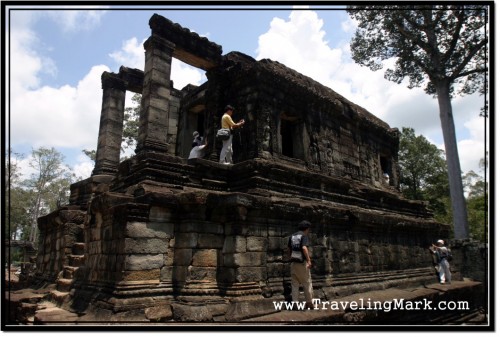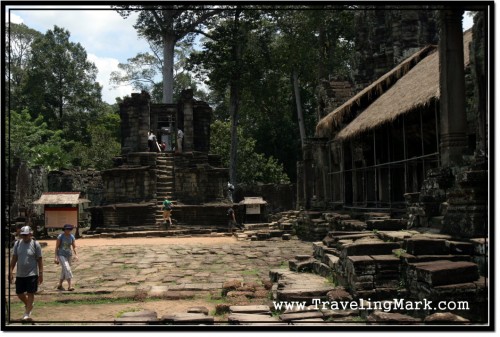Bayon Northern Library was the most intriguing structure I have found within the Angkor Thom state temple. The northern library is a small, stand alone building in the north-east corner of Bayon. There is a twin sister of the library located in the south-east corner of Bayon, but this one is in a very desolate state whereas the northern one has undergone extensive restoration by the team of Japanese professionals who brought it to the state at which I found it.

There were more locals and tourists at the northern library than anywhere else within Bayon. It was very intriguing to see so many people concentrated around one single structure so I felt inclined to come and check it out closely. To my disappointment there was absolutely nothing about this structure making it special, however in the process of exploring, I have learned a lot about the restoration process conducted by the JSA. The information panels had this to say:
Northern Library was one of the most dangerous structures in Bayon Temple complex. JSA carried out the restoration work in accordance with the following principles:
- Preserving not only the appearance, but also the original construction method to the furthest extent possible.
Restoration methods applied so far has focused on reinforcing the soil around the compound with the concrete wall and installation of sandstone on the outer side as a veneer. Considering lack of original materials and insufficient manpower at the beginning of the project, this was the best option available. JSA was committed to respecting the traditional construction methods to the fullest extent but was also determined to apply modern construction know-how to eliminate structural weaknesses of the original method.- Applying the stabilizing process of the compound soil layer using the solidification mechanism.
After successful experiments with slake lime, the decision has been made to add small amounts to the sand to reinforce the soil under and around the northern library. By applying this method, sandstone and laterite blocks fulfil both ornamental and structural functions of the construction material used in the past.- Procuring new materials.
In order to use original construction methods, it is necessary to procure the same material. Restoration of lost parts is impossible without sufficient supply of sandstone and laterite used during the original construction. After searching for stones with the co-operation of the Ministry of Mine and Energy of Cambodia for two years, JSA finally succeeded in obtaining sandstone that was in color and hardness close to the kind used in Bayon. Restoration works progressed after new laterite blocks were quarried, allowing for replacement of significantly deteriorated lateriate blocks in the foundation mass with new ones. The original delay was caused by immediate proximity of the quarry to the Khmer Rouge camp surrounded by heavily undermined minefields, and absence of good roads.- Restoration methods by the partial dismantling.
Because the roof and walls had suffered from considerable deformation due to uneven settlements, dismantling and reconstructions were necessary. East and west corners of the library were beyond repair, however because the central part of the foundation mass sank evenly, it was possible to leave it in its original condition, dismantling only the corner edges of the building.
